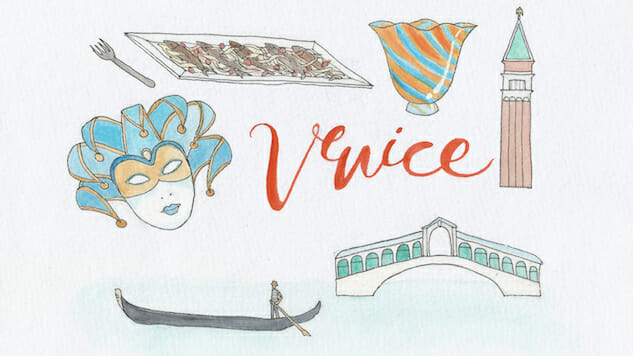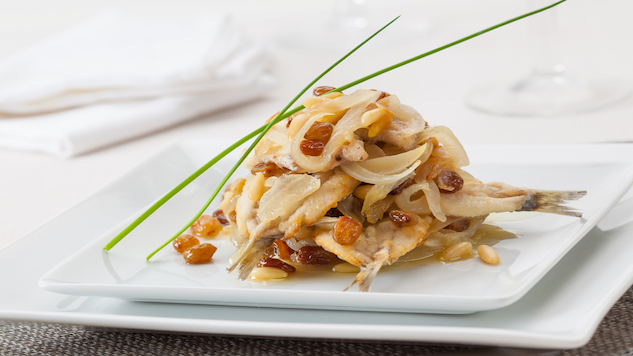City in a Dish: Sarde in Saor in Venice, Italy
Photo below by Rachel Moon/Shutterstock
When the waiter plucked the flat, rectangular plate between us, I felt my nose wrinkle involuntarily. Across the table my friend shook his head. “I wanted to hit the cicchetti bars. I wanted more of the baccalà mantecato.” I, too, loved that particular Venetian cicchetto, a dish involving creamed cod that’s way more delicious than it might sound. And I, too, enjoyed sampling the different small plates available at the cicchetti bars crowding Venice’s canals and narrow passages. But sarde in saor is perhaps Venice’s most distinctive traditional dish, invoking its days as the mightiest power in the Mediterranean, and there’s no way I was leaving without tasting it.
The perception for most outside Italy is that a standard “Italian” food exists, rather than distinct regional cooking with roots in an area’s climate, soil and history. A tomato is a tomato, except you’re much more likely to find them covering pizza in Naples rather than enhancing a risotto in Milan. And in Venice, where the past almost seems to overtake the present, a traditional food culture is still celebrated—particularly away from the most heavily touristed areas around the Piazza San Marco.
In St. Mark’s Square, dominated by the famous 12th-century cathedral that lends its name to the piazza, you feel like you might be anywhere in Europe. Elegant cafes line the arcaded sides, competing for the attention of tourists, while men speaking English inquire as to whether you’d like to be photographed with pigeons roosting on your head and shoulders. The church’s facade boasts many Byzantine elements, further contributing to the visitor’s sense of nowhereness.
It’s nearly impossible to escape the tourist hordes in Venice, which can play host to up to 70,000 visitors per day. But when you’ve absorbed the beauty of St. Mark’s, when you’ve crossed the Rialto Bridge, when you’ve already drifted down the Grand Canal, it’s time to wander. There’s nothing more a Venice guidebook author loves than to tell the reader to “throw away the map and get lost.” It’s likely an instruction included to save their own reputation, as a map here is nearly pointless, and your phone’s GPS is unlikely to help much, either. You will get lost on the twisted paths, and you’re unlikely to be able to tell one canal from the next. As the day seeps away and the mist creeps in, images will start to tug at the corner of your eyes. And you just might be convinced that you’ve stepped back in time.
Venice makes its living this way, convincing tourists they are time travelers who are seeing the city as it may have been 800 years ago, when the Republic of Venice ruled the Adriatic and dominated the spice trade.
The food reflected Venice’s place in the world; its exotic flavors reminding the diner of the city’s wealth and power. As Michael Krondl points out in The Taste of Conquest: The Rise and Fall of the Three Great Cities of Spice, dishes in medieval Venice resembled those of North Africa, tasting of almonds and raisins, ginger and cinnamon. Now tourists are more likely to eat the pizza and pasta of Southern Italy, while locals eat the “traditional” fare that developed in the 19th century when the humbled Venetians needed to rely on local ingredients.

Photo by Hans Geel/Shutterstock
Sarde in saor (pictured above) holds on, however, as the foodie’s bridge to the city’s past. It sounds rather frightening to a contemporary palate: a mound of fried sardines heaped together with onions, raisins, and sometimes pine nuts; doused in vinegar and sugar and left to marinate overnight. While some believe the dish emerged from Venice’s Jewish Ghetto, which dates from 1516, Krondl notes the dish is remarkably similar to one found in a 14th century cookbook. In fact, the sweet-and-sour combination would have appealed to Venetian residents returning from extended stays in the Middle East, where such plays on the taste buds were often encountered.
Yet despite typically savoring this meld of sweet-and-sour, and despite actually enjoying the humble sardine, I found myself eyeing the plate with trepidation. Sarde in saor is not a pretty dish, not even in that tiny, dimly lit restaurant where the woman beside me savored a lovely plate of mixed seafood over polenta. My plate, unfortunately, resembled a mass of glowing tentacles studded with tiny plump brains. After loading my fork, I had to close my eyes to take a bite. The flavors surprised me; the strong fishiness of the sardines is tempered by the sour vinegar bite, which in turn is subdued by a hint of sweetness.
Like the dish’s first impression, in Venice, so much is a facade. Coats of paint and sheets of marble disguise ordinary brickwork. The crowds hide the fact that, after the cruise ships leave and the last ferry has made for the mainland, the island is a lonely place, with most residents having been forced out due to rising rents. But, like in much of Italy, the food culture keeps those who remain connected to their past. The cicchetti bars provide a place for locals to gather throughout the day, nibbling at small plates of open-faced sandwiches. They are also where tourists are most likely to be drawn into conversation, as many of these spaces are tiny, with few seats, and mingling is made much easier by the small, inexpensive glasses of wine accompanying the food.
The cicchetti bars feel like a reminder of how Venice survived its fall, welcoming the outsider while continuing to foster a distinct Venetian culture in the local population. But sarde in saor takes the diner back even further, to those centuries of power and dominance that allowed the city to become what it is today, a mix of tastes and flavors, combining the local and the exotic.
Kirsten Schlewitz@kdschlewitz is a freelance writer and editor who eats, drinks and lives in Belgrade, Serbia.







































